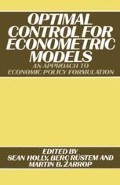Abstract
Whilst economists have been exploring the application of optimal control theory to macroeconomic policy formulation some engineers have been re-examining classical feedback theory. Recently the feedback literature has been extended to cover multivariable systems in a way which gives insight into questions of stability and control. In this paper some of the features of this feedback approach most relevant to economic applications are demonstrated using two different macroeconomic models. We begin with a version of Bill Phillips’ model which he used in his famous article (Phillips (1954)), to illustrate the application of control theory to economies. Then we turn to Wassily Leontief’s dynamic input-output model which is a large linear model used for planning purposes in many countries. Finally we examine how the feedback techniques could be used to analyse a nonlinear model.
Access this chapter
Tax calculation will be finalised at checkout
Purchases are for personal use only
Preview
Unable to display preview. Download preview PDF.
References
Aoki, M. (1973), ‘On Sufficient Conditions for Optimal Stabilization Policies’, Rev. Econ. Stud. vol. 40, pp. 131–8
Barker, T. S. (1971), ‘A Maximum Sustainable Growth Rate for British Industrial Outputs’, Rev. Econ. Studies, vol. 38, pp. 369–76.
Livesey, D. A. (1976), ‘A Minimal Realization of the Leontief Dynamic Input-Output Model’, in Polenske, K., and Skolka, J. Advances in Input-Output Analysis (Ballinger Books, Mass.) pp. 527–41.
MacFarlane, A. C. J. (1975), ‘Relationships between Recent Developments in Linear Control Theory and Classical Design Techniques, Measurement and Control, vol. 8, pp. 179–87, 219–23, 278–84, 319–24 and 371–5.
Phillips, A. W. (1954), ‘Stabilisation Policy in a Closed Economy’, Econ. J., vol. 64, pp. 290–323.
Cambridge University Department of Applied Economics (1970), ‘Exploring 1972 with Special Reference to the Balance of Payments’, no. 9 in A Programme for Growth (Chapman & Hall, London).
Editor information
Editors and Affiliations
Copyright information
© 1979 D. A. Livesey
About this chapter
Cite this chapter
Livesey, D.A. (1979). The Role of Feedback in Macroeconomic Policy. In: Holly, S., Rüstem, B., Zarrop, M.B. (eds) Optimal Control for Econometric Models. Palgrave Macmillan, London. https://doi.org/10.1007/978-1-349-16092-1_4
Download citation
DOI: https://doi.org/10.1007/978-1-349-16092-1_4
Publisher Name: Palgrave Macmillan, London
Print ISBN: 978-1-349-16094-5
Online ISBN: 978-1-349-16092-1
eBook Packages: Palgrave Economics & Finance CollectionEconomics and Finance (R0)

